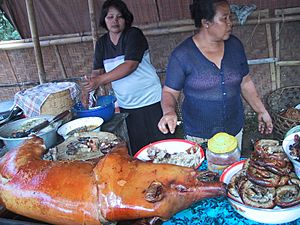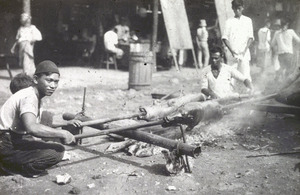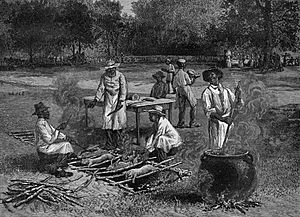Pig roast facts for kids
A pig roast (also called a hog roast) is a special party or event. It's all about cooking a whole pig slowly over a fire. This cooking method is a type of barbecue.
Pig roasts are a popular tradition in many parts of the world. You can find them in places like the Philippines, Puerto Rico, and Cuba. They are also very common in the United States. In Hawaii, a pig roast is part of a big party called a luau. In the Southern United States, it's often called a "pig pickin'." Many communities in Southeast Asia also enjoy pig roasts. These include Filipinos who are Catholic, Hindu Balinese people, and Buddhist Chinese people.
Contents
Pig Roast Traditions Around the World

The tradition of roasting a whole pig is very old. It has been around for thousands of years in many cultures. There are different ways to cook a pig. Some methods use an open fire, turning the pig on a spit. Others use special box grills. Many families enjoy a pig roast for holidays like Thanksgiving or Christmas.
In Miami, Florida, and other places with large Caribbean populations, pig roasts are often held on Christmas Eve. Hawaiian families might have a pig roast on Memorial Day.
In some Chinese communities, a roasted suckling pig is bought for special family events. It can also be used for business openings or as a spiritual offering. For example, a whole roast pig might be offered to the Jade Emperor when a Chinese film opens. This is done to wish for the film's success and to ward off bad luck.
Pig Roasts in Indonesia
In Indonesia, a roasted pig is called babi guling. It is mostly found in areas where most people are not Muslim. These places include Hindu Bali and Christian Batak lands. It is also popular among the Minahasa people, Toraja, and in Papua. Chinese Indonesians also enjoy it.
In Bali, babi guling is usually served with lawar and steamed rice. It is a very popular dish in Balinese restaurants. For the Batak people, babi guling is a must-have for wedding celebrations. In Papua, pigs are roasted with yams using hot stones in a pit. This cooking method is called bakar batu, and it is a big cultural event.
Pig Roasts in the Philippines
In the Philippines, a former Spanish colony, a roasted pig is called lechon. It is also known as lechon baboy or litson baboy. This dish is a main highlight at many celebrations and fiestas.
Pig Roasts in Puerto Rico and Cuba
Pig roast, or lechon asado, is very popular in many former Spanish colonies. It is part of Puerto Rico's national dish. It is usually served with arroz con gandules. In Puerto Rico and Cuba, pig roasts happen all year. However, they are most common on New Year's Eve and Christmas.
In the Dominican Republic, puerco a la puya is a traditional part of the Christmas Eve meal. In Spain, this dish is called a suckling pig or lechon asado. Hog roasts are becoming more popular across Spain, especially in the south.
Pig Roasts in the United Kingdom
In the UK, pig roasting is often called a "hog roast." It is popular for many events, especially parties and celebrations. It is usually an outdoor event. The pig is often roasted on a spit, turning under a flame. Sometimes it is cooked in a large oven. Pigs weighing about 130 pounds (60 kg) are common in the UK. The pig is usually cooked in a gas machine. The pig's skin is scored and covered in water and salt. This helps make the crispy crackling.
Long ago, during Saxon times, roasting a wild boar was a main dish at Yuletide celebrations. The head was often seen as the best part.
Pig Roasts in the United States
In the United States, roasting a whole pig has been a tradition for over 200 years. It is very popular in the Southern United States. There, it is closely linked to barbecue. From Virginia down to the Florida Panhandle and west to the Mississippi River, pork has been a favorite meat since colonial times.
Pigs were easy to raise for small farmers and plantation owners. They could be sent into the woods and gathered when needed. People in the mountains would drive their pigs to market each fall. They would fatten them up on nuts and acorns.
Even George Washington mentioned attending a barbecue in his journal in 1769. His home, Mount Vernon, had a smokehouse. Like many plantation owners, he raised pigs for slaughter in November. After the meat was cured into ham and bacon, some whole pigs would be roasted over hot coals as a treat. In Louisiana, French-speaking Cajuns have a traditional dish called Cochon de lait for family gatherings.
How to Cook a Pig Roast
Cooking a whole pig is a big event. A pig, often weighing 80–120 pounds (35 to 45 kg), is split in half. Then it is spread onto a large charcoal or propane grill. The grills can be homemade or custom-made.
In a Hawaii-style pig roast, a large pit is dug into the ground. It is lined with banana leaves. Lava rocks are heated over a fire until they are very hot. The hot rocks are placed into the pit. A seasoned pig is put inside and covered with more banana leaves. These leaves help keep the heat in and add flavor.
In an American Cuban-style pig roast, a "caja china" is a popular way to roast a whole pig. This is a roasting box, often made from concrete blocks and steel mesh. Another popular method uses a special pig roasting box. The cooking process is often a group effort, usually done by men. Friends or family help the host. It usually takes four to eight hours to cook the pig completely. The pig is often started with the meat side down. It is flipped once it stops dripping fat. When done, the meat should be so tender it falls off the bone. Guests then chop, pull, or pick the meat off the roasted pig.
In the Philippines, the pig is often stuffed with spices. It is placed on a bamboo spit and roasted over hot coals.
In Puerto Rico, the pig is prepared with adobo mojado. This is a wet seasoning. It contains crushed garlic, black pepper, salt, orégano brujo, olive oil, and wine vinegar.
See also
 In Spanish: Asado de cerdo para niños
In Spanish: Asado de cerdo para niños



